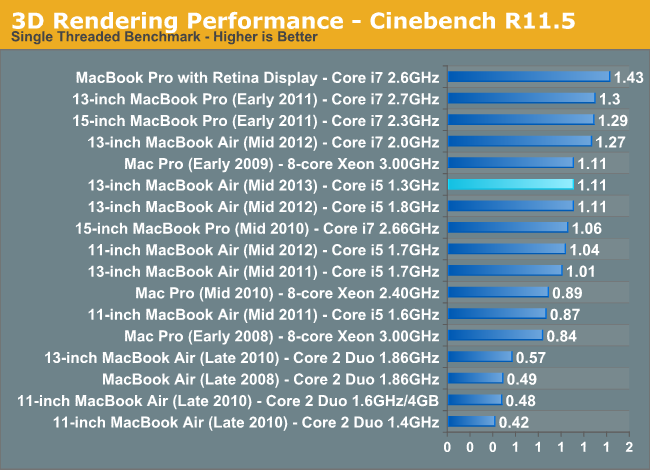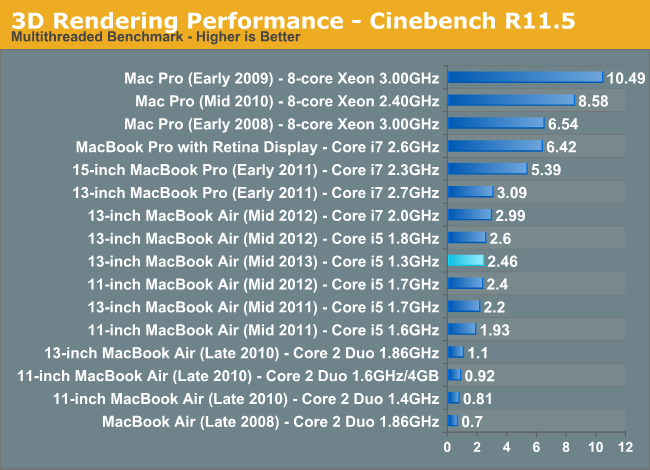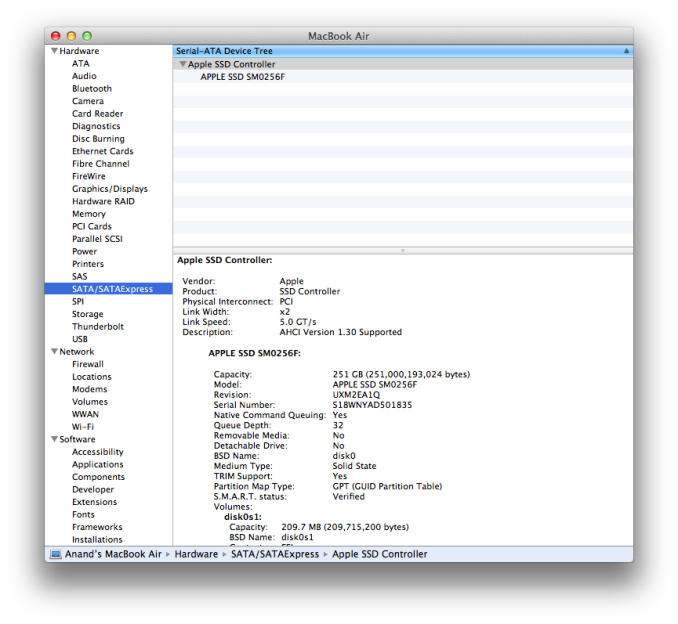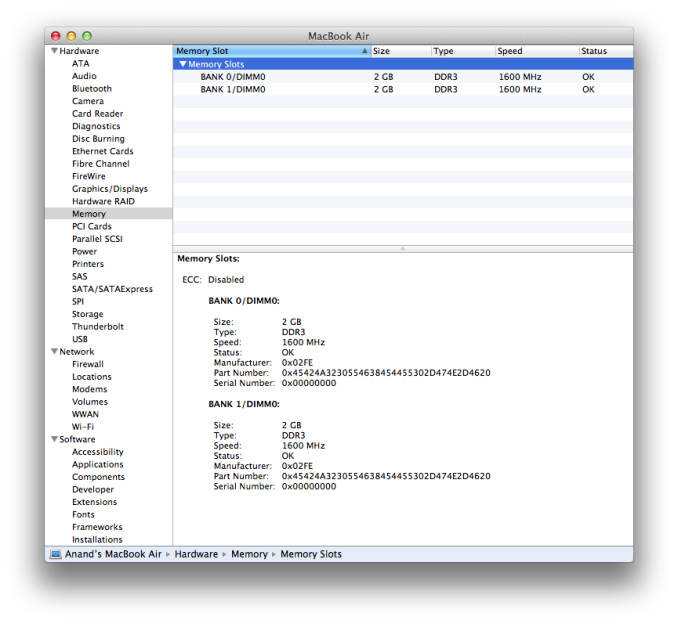2013 MacBook Air: PCIe SSD and Haswell ULT Inside
by Anand Lal Shimpi on June 10, 2013 10:01 PM EST- Posted in
- Mac
- Storage
- SSDs
- Apple
- MacBook Air

This morning Apple updated its MacBook Air to Intel's Haswell ULT silicon. The chassis itself didn't get any updates, nor did the displays. Both the 11 and 13 inch models retain their non-Retina 1366 x 768 and 1440 x 900 displays. There's a slight increase in battery capacity. The 11-inch model moves to 38Wh (8.6%) while the 13-inch model goes to 54.4Wh (8.8%). The big changes however are on the CPU, NAND and DRAM fronts.
With the new MacBook Air, Apple moves to a Core i5-4250U. The base clock drops to 1.3GHz across all of the models, but max turbo remains at 2.6GHz. Although the base clock is lower, I wouldn't expect substantially lower performance since the max turbo is unchanged as is the chassis that has to dissipate the thermals. To confirm, I ran a couple of Cinebench tests and generally found performance similar to that of last year's models:


The 1.8GHz i5 in the 13-inch ended up being a bit quicker than the 1.3GHz 4250U this generation in the multithreaded test, but in single threaded performance the two are equal. The impact on the MT test is about 5%, it's there but not substantial. Don't be fooled by base clock, it's the combination of base clock, max turbo and cooling solution that'll determine performance here. As we found in our Haswell ULT review, CPU performance isn't something you can expect to see more of with Haswell vs. Ivy Bridge in these low wattage platforms.
You can get a 1.7GHz Core i7 upgrade with a 3.3GHz max turbo (i7-4650U). Both parts have Intel GT3 graphics clocked at a max of 1GHz on the i5 and 1.1GHz on the i7. Since the max GPU clocks are south of 1.2GHz, this is officially Intel's HD 5000 graphics and not Iris despite using the same silicon. The GPU base clock drops from 350MHz down to 200MHz, which should help reduce idle power consumption.
| 2013 MacBook Air Lineup | ||||||
| 11.6-inch | 11.6-inch (high-end) | 13.3-inch | 13.3-inch (high-end) | |||
| Dimensions |
H: 0.11-0.68" (0.3-1.7cm) W: 11.8" (30cm) D: 7.56" (19.2cm) |
H: 0.11-0.68" (0.3-1.7cm) W: 12.8" (32.5cm) D: 8.94" (22.7cm) |
||||
| Weight | 2.38 lbs (1.08kg) | 2.96 lbs (1.35kg) | ||||
| CPU | 1.3GHz dual-core Core i5 | 1.3GHz dual-core Core i5 | ||||
| GPU | Intel HD 5000 | |||||
| RAM | 4GB LPDDR3-1600 | |||||
| SSD | 128GB PCIe SSD | 256GB PCIe SSD | 128GB PCIe SSD | 256GB PCIe SSD | ||
| Display Resolution | 1366 x 768 | 1440 x 900 | ||||
| Ports | Thunderbolt, 2x USB 3.0, headphone jack | Thunderbolt, 2x USB 3.0, SD card slot, headphone jack | ||||
| Price | $999 | $1199 | $1099 |
$1299 |
||
On the storage front, Apple officially leads the charge with the move to PCIe based SSDs. The upcoming Mac Pro, as well as the new MacBook Airs both use PCIe based SSDs instead of SATA drives. A quick look at OS X's system profiler reveals a PCIe 2.0 x2 interface, capable of 1GB/s in each direction.
The drive in my system uses a Samsung controller, although I've heard that SanDisk will have a PCIe solution for Apple as well. A quick run through Quick Bench reveals peak sequential read/write performance of nearly 800MB/s:
This is a pretty big deal, as it is probably the first step towards PCIe storage in a mainstream consumer device that we've seen. I'm still awaiting official confirmation as to whether or not this is an M.2 based solution or a proprietary connector. Update: It's a custom Apple design, not M.2. Since there's no PCIe routed off of the CPU in Haswell ULT, these 2 lanes come from the on-package PCH.
The other big change is the move from DDR3L to LPDDR3, a new feature supported by Haswell ULT. I need to go back and dig through the Haswell ULT datasheets again, but I believe the total memory interface width remains at 128-bits wide even if you use LPDDR3 - you just get lower power consumption.
Obviously battery life is the biggest improvement here with the new MacBook Air. Thanks to Haswell's platform power optimizations, Apple claims up to 12 hours on a single charge for the 2013 13-inch MacBook Air. Given the improvements I saw in our Haswell ULT review, I don't doubt that we could see some very good numbers out of these notebooks.
I just got my hands on a 13-inch 2013 MBA and I'll be running performance tests (including the first look at Intel's HD 5000 graphics) over the coming days. I'm still traveling until Thursday but I'll do my best to run battery life tests while I'm on the road as well. More soon!













174 Comments
View All Comments
Mxheadroom - Tuesday, June 11, 2013 - link
Bullshit. The socket may look similar, but the protocol was always sata. This is the first Apple device that direct connect the AHCI via PCIe.Bob Todd - Tuesday, June 11, 2013 - link
I love the battery life improvement with Haswell, especially for the 13". However, these make the 13" rMBP look like a bargain if you can deal with the (still very competitive to most of what's out there) 7 hour battery life. The Airs seem like a decent deal in absolute base configuration, but I'd want 8GB RAM and 256GB of storage. That puts the 13" Air at $1400. You can get a 13" rMBP with 8GB/256GB/faster regular voltage i5 for $1479 (for me with free 2 day shipping and no tax). You lose out on a whopping 5 hours of additional battery life and you've got the lowly HD4000 trying to drive all those pixels, but that's still more tempting for me.Bkord123 - Tuesday, June 11, 2013 - link
That's right where I'm at also. I can't decide!aliasfox - Tuesday, June 11, 2013 - link
Or if you're willing to wait 1-2 months, you'd probably be able to get the rMBP with Haswell as well - alternatively, have the choice of a clearance Ivy Bridge or new Haswell.If you put it that way ($1400 vs $1479, RAM and storage matching), the only things the Air really has going for it are 0.5 lbs and a few extra hours of battery life.
That said, the last time I played with a rMBP 13" it felt laggier than it should be given that it's a premium computer sold at a premium price. Let's hope a Haswell model (with Iris Pro?) corrects that deficiency.
Elwe - Tuesday, June 11, 2013 - link
It think the base 13" Pro (with Retina) is $1499, but for me, your point is a good one. If you need/wantthe extra ram (and not even close to everyone does, especially given the responsiveness of the SSD) and you need/want the 256GB SSD, a $100 difference that gives you that awesome screen (and presumably bit better cpu, when the Haswell line comes to down) seems worth it. But the screen is wasted on lots of people for lots of uses, clearly (just reality), and the extra weight is still noticeable. If I was a student, I still think I would probably stick with the Air. The battery life will be worth it to a lot of people (I know I really am interested in it, and I have access to power throughout the day though it is more of a pain to use than I would like).But it puts into greater context why Apply released the 13" at $1699 (though I really appreciated the drop). You can either say the more nicely configured Airs are too expensive (what most people are going to say) or the 13" Mac Pro (with Retina) is cheap.
I think Apple is going to sell a tone of the 4GB/128GB 11" and 13" models for the school year. I think most people are going to avoid the older Macbook Pros (withou Retina) from here on out, and the Retina options are still an unnecessary option for lots of people.
Neurus - Wednesday, June 12, 2013 - link
You also gain a few pounds… the Airs are really light :)Sm0kes - Sunday, June 16, 2013 - link
It's actually less than a pound, the 13'' air is 0.5lbs less than the 13'' rMBP.ntafy - Tuesday, June 11, 2013 - link
I wish Anand had included the 1.7GHz i7 in there as well. I'm currently between getting the latest MBA13 1.7GHz i7 /8/256 or the rMBP13 2.6GHz i5 /8/256. If the 1.7 offers comparable performance, it's an easy choice.willstay - Tuesday, June 11, 2013 - link
Please test battery performance when Windows 8 is installed in it too.willstay - Wednesday, June 12, 2013 - link
After researching a little and finding features like Unity of VMWare Fusion and Coherence of Parallels. I wish battery performance is tested against Outlook running in one of those.